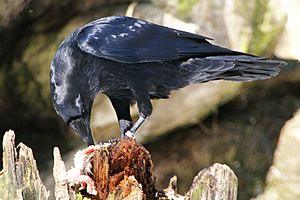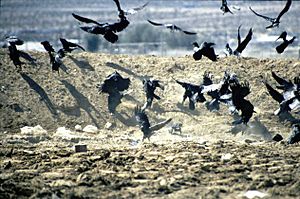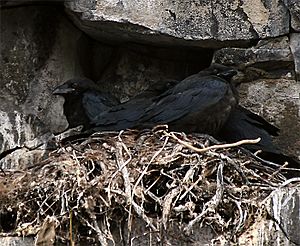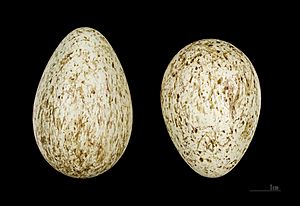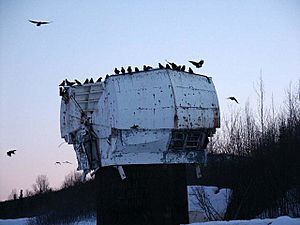Common raven facts for kids
Quick facts for kids Common raven |
|
|---|---|
 |
|
| At Bodega Head State Park, US | |
| Conservation status | |
| Scientific classification | |
| Kingdom: | |
| Class: | |
| Order: | |
| Family: | |
| Genus: | |
| Binomial name | |
| Corvus corax |
|
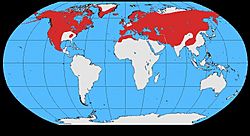 |
|
| Common raven range | |
The common raven (Corvus corax), also called the northern raven, is a big, black passerine bird. You can find it all over the Northern Hemisphere. It is the most widespread of all crow family birds. There are at least eight different types, or subspecies, of common ravens. They look quite similar, but recent studies show they have important genetic differences.
The common raven is one of the two largest birds in the crow family. It might even be the heaviest songbird! A grown-up raven is about 63 centimeters (25 inches) long. It can weigh around 1.2 kilograms (2.6 pounds). Common ravens can live for a long time in the wild, sometimes over 20 years. Only a few other songbirds, like the satin bowerbird, live longer. Young ravens might travel in groups. But later, they find a partner for life. Each pair then protects their own home area.
Common ravens have lived alongside humans for thousands of years. In some places, there were so many that people saw them as a problem. They are very successful because they eat almost anything. Ravens are super adaptable and good at finding food. They eat dead animals, insects, grains, berries, fruit, small animals, and even leftover human food.
Ravens are also very smart. They can solve problems in amazing ways. For centuries, ravens have been important in stories, myths, and art. Many cultures, like those in Scandinavia, ancient Ireland, and North America, saw the common raven as a special spiritual figure or even a god.
| Top - 0-9 A B C D E F G H I J K L M N O P Q R S T U V W X Y Z |
What is a Common Raven?
Raven Family Tree
The common raven is related to several other birds. Its closest relatives are the brown-necked raven, the pied crow from Africa, and the Chihuahuan raven from North America.
Some experts say there are 11 different types of common ravens. Others recognize eight main ones. These different types are called subspecies.
How Ravens Evolved
Common ravens first appeared in the "Old World" (Europe, Asia, Africa). They then crossed a land bridge called Beringia to get to North America. Scientists have studied raven DNA from all over the world. They found that ravens fall into two main groups. One group is found only in the southwestern United States. The other group is found everywhere else in the Northern Hemisphere.
These two groups look alike, but their genes are different. They started to become separate about two million years ago. This suggests that ravens settled in California a long time ago. They might have been separated from their relatives in Europe and Asia during an ice age. Later, another group of ravens arrived in North America from Asia.
What Do Ravens Look Like?

A grown common raven is usually between 54 and 67 centimeters (21 to 26 inches) long. Its wingspan can be from 115 to 130 centimeters (45 to 51 inches). They weigh between 0.69 and 2 kilograms (1.5 to 4.4 pounds). This makes the common raven one of the heaviest passerine birds. Ravens from colder places, like the Himalayas, are usually bigger. They also have slightly larger beaks. Ravens from warmer areas are smaller with smaller beaks.
Their bill is large and a bit curved. It's one of the biggest bills among songbirds. Only the thick-billed raven might have a bigger one. Ravens have a long, wedge-shaped tail. Their feathers are mostly black and shiny, with a blue or purple glow in the light. Their eyes are dark brown. The feathers on their throat are long and pointed. Young ravens look similar but are a bit duller. Their eyes are blue-grey.
Ravens are different from their cousins, the crows. Ravens are bigger and have a heavier black beak. They also have shaggy feathers around their throat and above their beak. When flying, you can tell ravens from crows by their tail shape. Ravens have a wedge-shaped tail, while crows have a fan-shaped tail. Ravens also have bigger wings and fly more steadily. They often glide more than crows. Even though they are big, ravens are very good at flying. Their feathers make a soft, rustling sound when they fly.
The sound ravens make is also special. Their usual call is a deep croak. It sounds much richer and deeper than a crow's call. Ravens have many different sounds. Scientists have recorded 15 to 30 types of calls. These calls are used for talking to each other. They have alarm calls, chase calls, and flight calls. Their special call is a deep prruk-prruk-prruk. They also make a high, knocking toc-toc-toc, a dry, grating kraa, and a low rattling sound. Some of their calls even sound musical.
Like other birds in the crow family, ravens can copy sounds. They can even mimic human speech! Ravens also make non-vocal sounds, like wing whistles and snapping their bills. Female ravens sometimes clap or click more than males. If a raven loses its partner, it might make its partner's calls to try and get them to come back.
Where Do Ravens Live?
Common ravens can live in many different climates. They have the largest range of any bird in their group. You can find them across the Northern Hemisphere. This includes cold Arctic areas, mild temperate places in North America and Eurasia, and even the deserts of North Africa. They also live on islands in the Pacific Ocean. In places like Tibet, they have been seen at very high altitudes, up to 5,000 meters (16,400 feet). They have even been spotted as high as 6,350 meters (20,600 feet) on Mount Everest.
Most common ravens like wooded areas with lots of open land nearby. They also like coastal regions for building their nests and finding food. In some areas where many humans live, like California, ravens have found lots of food. Because of this, their numbers have grown a lot. Along coasts, ravens often build their nests on sea cliffs. Coastal areas are good for ravens because they have easy access to water and many different food sources. The weather there is also usually stable, not too hot or too cold.
Ravens live in many different environments. But they prefer places with lots of hills and valleys. When their environment changes a lot, these birds can get stressed.
How Do Ravens Behave?
Common ravens usually travel in pairs. But young birds might form flocks. Ravens can sometimes be quarrelsome with each other. However, they are very devoted to their families.
What Do Ravens Eat?
Common ravens are omnivores. This means they eat both plants and animals. They are also very opportunistic. Their diet can change a lot depending on where they are, the season, and what food they happen to find. For example, ravens in Alaska get about half their energy from hunting small rodents. The other half comes from eating dead animals like caribou.
In some places, ravens are mainly scavengers. They eat carrion (dead animals) and the insects that live on them. When there's a very large dead animal, ravens might have to wait. They wait for another predator, like a wolf, to tear it open. Then they can get to the meat.
Plant foods they eat include grains, berries, and fruit. They also hunt small insects, amphibians, reptiles, small mammals, and birds. Ravens might even eat undigested parts of animal poop or human food waste. They often hide extra food, especially fatty items. They learn to hide it where other ravens can't see it. Ravens also steal food that other animals, like the Arctic fox, have hidden. They sometimes follow grey wolves to eat the leftovers from their hunts in winter. Ravens are also known to raid bird nests. They will take eggs, baby birds, and sometimes even adult birds if they get a chance. They are a big threat to the critically endangered California Condor because they eat condor eggs.
Ravens that nest near human garbage dumps eat more food waste. Those near roads eat more animals killed by cars. Ravens that nest far from these food sources eat more insects and plants. Baby ravens that eat human garbage tend to grow up more successfully.
Sometimes, young ravens will call other ravens to a big food source, like a dead animal. They do this with loud yells. One idea is that this helps the young ravens outnumber the adult ravens. This way, they can eat without being chased away. Another idea is that ravens work together to share information about large dead animals. These animals are too big for just a few birds to eat.
Research also suggests that common ravens help spread seeds. They choose good places to drop seeds, which helps new plants grow.
Who Hunts Ravens?
Because of their size, their ability to gather in groups, and their strong defense skills, common ravens have few natural predators. Predators that eat raven eggs include owls, martens, and sometimes eagles. Ravens are very good at protecting their young. They usually succeed in scaring away threats. They attack predators by flying at them and lunging with their big beaks. Humans are sometimes attacked if they get too close to a raven nest. But serious injuries are rare.
A few large birds of prey have been known to hunt ravens. In America, these include great horned owls, northern goshawks, bald eagles, golden eagles, and red-tailed hawks. It's possible that the hawks only attack young ravens. In Eurasia, predators include golden eagles, Eurasian eagle-owls, and white-tailed eagles. Since ravens can be dangerous prey, these birds of prey usually have to surprise them. Most attacks are on young ravens that have just learned to fly.
Very rarely, large mammals like lynxes, coyotes, and cougars have also attacked ravens. This usually happens at a nest site. It is more likely when other prey animals are scarce for the carnivores. Ravens are very careful around new dead animals. In North America, they have been seen waiting for American crows or blue jays to approach first before they start eating.
How Ravens Breed
Young ravens start to look for partners early on. But they might not form a pair for another two or three years. Flying stunts, showing how smart they are, and proving they can find food are important for attracting a mate. Once a pair forms, they usually stay together for life. They often nest in the same spot each year.
Breeding pairs need their own territory before they build a nest. They fiercely protect their territory and its food. The size of their territory depends on how much food is in the area. The nest is a deep bowl made of large sticks and twigs. It's held together with roots, mud, and bark. The inside is lined with soft material, like deer fur. Nests are usually built in big trees or on cliff ledges. Sometimes, they use old buildings or utility poles.
Females lay between three and seven eggs. The eggs are pale bluish-green with brown spots. The female sits on the eggs for about 18 to 21 days. The male might stand over the young to shelter them, but he doesn't usually sit on them. Young ravens learn to fly at 35 to 42 days old. Both parents feed them. They stay with their parents for about six months after they can fly.
In most places, ravens start laying eggs in late February. In colder areas, it's later, like April in Greenland. In Pakistan, they lay eggs in December. Eggs and baby ravens are sometimes eaten by large hawks, eagles, large owls, and martens. Adult ravens are rarely hunted. They are often successful at defending their young. This is because they are smart, big, and work together. They have even been seen dropping stones on predators that get too close to their nests.
Common ravens can live a very long time, especially in zoos or protected places. Some ravens at the Tower of London have lived for over 40 years. In the wild, they usually live for 10 to 15 years. The longest known lifespan for a wild raven was 23 years and 3 months.
How Smart Are Ravens?
The brains of common ravens are among the largest of any bird. They are very good at solving problems. They also show other smart behaviors like copying others and having sudden "aha!" moments.
One scientist, Derek Bickerton, says that ravens are one of only four animals known to show "displacement." This means they can talk about things that are not right in front of them. The other animals are humans, bees, and ants.
Young ravens sleep together at night. But they usually look for food alone during the day. If a raven finds a large dead animal that is guarded by adult ravens, it will go back to its roost. There, it will tell the other ravens about the food. The next day, a group of ravens will fly to the dead animal and chase away the adults. This suggests ravens can communicate about things far away in time and space.
Common ravens are "inventors." This means they can figure out how to solve problems. Many of the amazing things ravens do were once thought to be just natural instincts. But now we know that their ability to solve problems and learn from each other shows they are very intelligent. This is unusual for animals that are not human.
Another experiment showed that some ravens could intentionally trick other ravens.
Ravens have been seen calling wolves to dead animals. The wolves open the animal, which makes it easier for the birds to eat the leftovers. Ravens also watch where other ravens bury their food. They remember these spots so they can steal from them. This happens so often that ravens will fly extra distances to find better hiding places for their food. They have also been seen pretending to hide food without actually dropping it. This probably confuses other ravens watching them.
Common ravens are known to steal and hide shiny objects. These include pebbles, metal pieces, and golf balls. One idea is that they collect shiny things to impress other ravens. Other research suggests that young ravens are very curious about new things. They are attracted to bright, round objects because they look like bird eggs. Older ravens lose this strong interest in unusual things. They become very cautious of new things.
Do Ravens Play?
Scientists are learning more about how much birds play. Young common ravens are among the most playful bird species. They have been seen sliding down snowbanks, just for fun! They even play games with other animals, like playing "catch-me-if-you-can" with wolves, otters, and dogs. Ravens are also known for amazing flying displays. They fly in loops or link their talons (claws) together in the air.
They are also one of the few wild animals that make their own toys. They have been seen breaking off twigs to play with together.
Ravens and Humans
Protecting and Managing Ravens
Compared to many smaller crow species, ravens prefer quiet mountain or forest areas. They also like rural places more than cities. In some areas, their numbers have grown a lot. They have become a problem for farms. Common ravens can damage crops like nuts and grain. They can also harm livestock, especially by killing young goats, lambs, and calves. Ravens usually attack the faces of young livestock. However, ravens are more likely to be scavenging (eating dead animals). Sometimes, ranchers might mistake this for hunting.
In the western Mojave Desert, more human homes and buildings have caused a huge increase in the raven population. Their numbers have grown about 16 times in 25 years! Towns, landfills, and artificial ponds give ravens lots of food and water. Ravens also find places to nest on utility poles and in trees. They are also attracted to dead animals on highways. This big increase in ravens in the Mojave Desert has worried people who care about the desert tortoise. This tortoise is a threatened species. Common ravens hunt young tortoises, which have soft shells and move slowly.
Ravens in Culture
All over the Northern Hemisphere, and throughout human history, the common raven has been a powerful symbol. It has been a popular subject in myths and stories.
In some Western cultures, ravens have long been seen as signs of bad luck, death, or evil. This is partly because of their all-black feathers and because they eat dead animals. In Sweden, ravens are thought to be the ghosts of murdered people. In Germany, they are seen as the souls of the damned. In Danish folklore, special ravens called valravne were said to gain human knowledge if they ate a king's heart. They could do bad things, lead people astray, and had superhuman powers.
Just like in old myths, the common raven often appears in more modern stories. You can find them in the works of William Shakespeare. Perhaps most famously, they are in the poem "The Raven" by Edgar Allan Poe. Ravens have also appeared in books by Charles Dickens, J. R. R. Tolkien, Stephen King, and George R. R. Martin.
Ravens are still used as symbols today. They are the national bird of Bhutan. The Kings of Bhutan even wear a Raven Crown. The raven is also the official bird of the Yukon territory in Canada. It is on the coat of arms of the Isle of Man, which was once a Viking colony.
In Persia and Arabia, the raven was seen as a bird of bad luck. But a book from the 14th century says that ravens were used in falconry (hunting with birds of prey).
Images for kids
-
A valkyrie speaks with a raven in a 19th-century illustration of the Old Norse poem Hrafnsmál ("raven song") by Frederick Sandys
See also
 In Spanish: Cuervo grande para niños
In Spanish: Cuervo grande para niños





